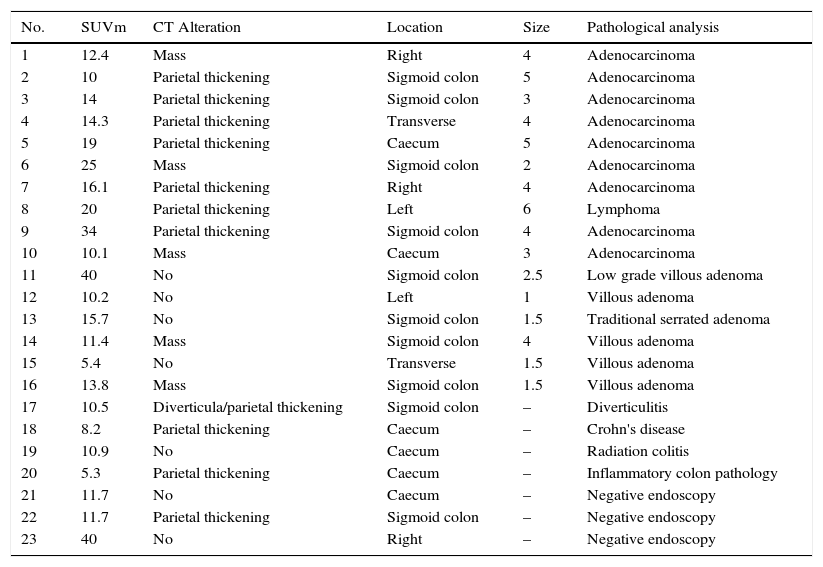To assess the frequency of focal colonic uptake as an incidental observation in 18F-FDG PET/CT studies, and to correlate this finding with histopathological results.
Material and methodsA systematic analysis of 30 studies reporting focal colonic uptake out of a total of 3176 PET/CT studies with 18F-FDG was carried out. Patients with known colorectal neoplasia were excluded. The maximum standardized uptake values (SUVm) and the morphological findings provided by the CT were recorded. The studies were reported by a radiologist and a nuclear medicine physician. The findings were compared with endoscopy and pathology findings.
ResultsOf the 30 patients with focal hypermetabolic lesions of the colon (0.94%), 15 were men and 15 were women with ages between 27 and 73 (mean 55 years). The reasons for PET/CT were bronchopulmonary cancer (4), breast cancer (4), tumor of unknown origin (4), melanoma (3), renal carcinoma (3), cervical neoplasia (2), adenocarcinoma of ovary (2), and others (8). Of the 23 colonoscopies performed, 10 patients (43.4%) had malignant lesions, 6 (26.1%) had pre-malignant lesions, and in 7 patients (30.4%) no lesion was identified or was benign. No endoscopy was performed on 7 patients for various reasons (patient refusal to perform the study, advanced oncological disease). An analysis was performed with the SUVm, with no statistically significant differences between malignant–premalignant lesions and benign lesions.
ConclusionsFocal uptake in the colon of 18F-FDG PET/CT has clinical relevance, especially when it is associated with morphological lesions on CT. As it may be a second tumor or a pre-malignant lesion, it is recommended that all focal uptake of the colon with or without abnormal CT be evaluated with endoscopy.
Evaluar la frecuencia de la captación focal de colon como observación incidental en estudios 18F-FDG PET/TC. Correlacionar dicho hallazgo con resultados histopatológicos.
Material y métodosSe analizaron de forma sistemática 30 estudios en los que se constató captación focal del colon de un total de 3.176 PET/TC con 18F-FDG. Se excluyeron pacientes con neoplasia colorrectal conocida. Se consignó el valor del SUV máximo (SUVm) y el hallazgo morfológico de la TC. Los estudios fueron informados por un médico radiólogo y un médico nuclear. Los hallazgos fueron correlacionados con la endoscopia y la anatomía patológica.
ResultadosDe los 30 pacientes con lesiones focales hipermetabólicas del colon (0,94%), 15 eran hombres y 15 mujeres con edades comprendidas entre los 27 y 73 años (media 55 años). Los motivos de realización de la PET/TC fueron: cáncer broncopulmonar (4), cáncer de mama (4), tumor de origen desconocido (4), melanoma (3), carcinoma renal (3), neoplasia de cuello uterino (2), adenocarcinoma de ovario (2) y otros (8). Se realizaron 23 fibrocolonoscopias: 10 pacientes (43,4%) presentaron lesiones malignas, 6 pacientes (26,1%) lesiones premalignas y en 7 pacientes (30,4%) no se identificó ninguna lesión o esta fue benigna. En 7 pacientes no se hizo endoscopia por diversos motivos (rechazo del paciente para realizar el estudio, enfermedad oncológica avanzada). Se correlacionó con valores de SUVm y no se encontraron diferencias estadísticamente significativas entre lesiones malignas-premalignas y las lesiones benignas.
ConclusionesLa captación focal en colon de 18F-FDG tiene relevancia clínica sobre todo asociada a lesión morfológica en TC, puede tratarse de un segundo tumor o una lesión premaligna. Se recomienda que todas las captaciones focales del colon sean valoradas con endoscopia, tengan o no alteraciones en TC.
Article

Revista Española de Medicina Nuclear e Imagen Molecular (English Edition)










